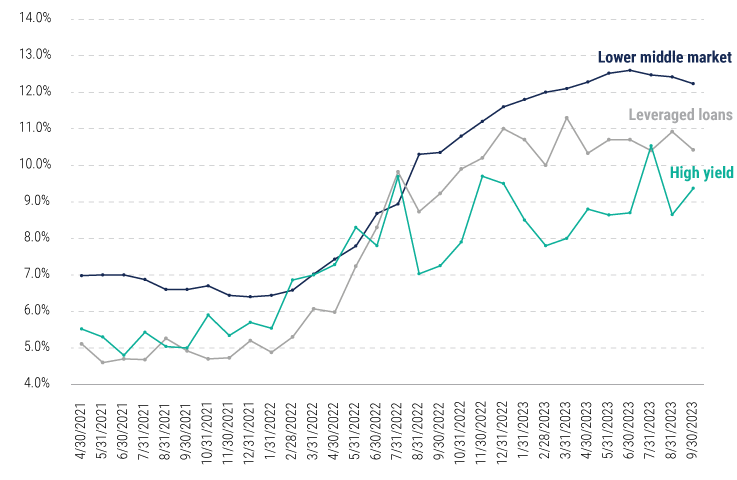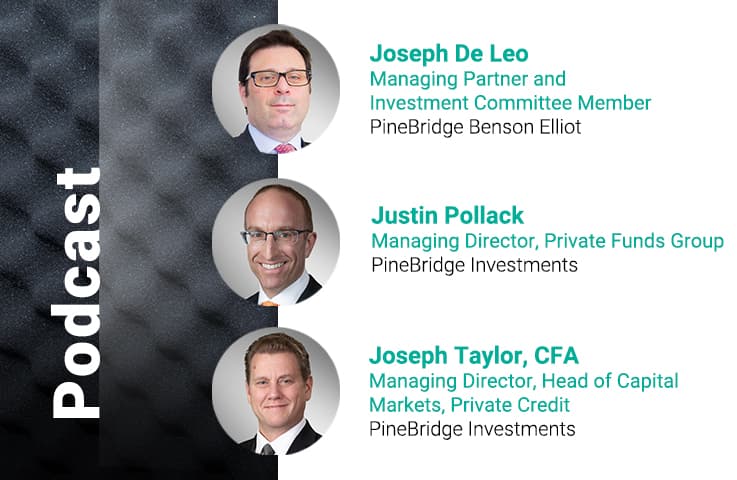2024 Private Credit Direct Lending Outlook: Three Key Factors Investors Need to Watch

James Fisher
Head of Private Capital

Joseph Taylor, CFA
Managing Director, Head of Capital Markets
In our view, 2024 will be marked by divergence among private credit lenders as less-benign conditions expose underperformers, with the impact evidenced by a higher incidence of defaults, losses, and payments in kind.
M&A is likely to warm up in 2024, with pent-up dealmaking creating ample lending opportunities and closing the gap between buyer and seller expectations.
Private credit investors should keep the liquidity and transparency of portfolios top of mind in light of ongoing macro challenges, especially regarding fixed-charge and interest coverage, variable versus fixed costs, and leverage ratios.
We believe the lower-middle-market asset class is well positioned entering 2024 and will continue to provide compelling risk-adjusted return potential.

We believe a period of marked divergence lies ahead across private credit direct lending in 2024, fueled by a sustained high interest rate environment and the impact of varying portfolio approaches. Specifically, while the overall private credit direct lending (lower middle market) asset class has continued to show durable, stable returns across various macro environments, the specific asset mix, sector focus, and approach to credit risk are all factors that drive performance outcomes – and create the many “varieties” of private credit.
We continue to believe the opportunity set for investors in the private credit direct lending segment remains robust and deep enough to enable a selective approach, including both new and add-on lending opportunities. While merger and acquisition (M&A) activity was somewhat chilled in 2023, it’s likely to warm up in the coming year toward a more normal pace, fueled in part by some pent-up dealmaking.
With current yields of roughly 12%1 combined with a 2024 environment that we expect to remain generally lender-friendly on a relative basis, we believe the lower middle market direct lending asset class is well positioned for the coming year, maintaining its attractive risk-adjusted return potential.
Here we explore our key convictions for the year ahead.
Key Convictions
1) Divergence is the keyword for 2024 among private credit portfolios.
While private credit direct lending has generally benefited from a benign environment over the last decade, sustained elevated interest rates over the past year and a half have hampered cash flow for over-leveraged portfolio companies and those with weak business models or cyclical earnings. We believe 2024 will be a year that exposes underperformers, with the impact evidenced by a higher incidence of defaults, losses, and payments in kind. Now more than ever, it’s crucial to maintain investment discipline in this market segment, and for potential investors to assess their partners accordingly.
We believe lower-middle-market companies (with EBITDA of $7.5 million to $30 million) that boast long operating histories, leadership positions in their market segments, and seasoned management teams remain compelling investments. While private credit comes in many different varieties, PineBridge has historically focused on traditional lower-middle-market direct lending – with conservative structures, traditional sectors, and investing alongside experienced private equity sponsors.
We consider businesses that have shown stability and durability during both stronger and weaker environments and which benefit from real cash generation and a competitive “moat” – i.e., distinct relevance and value to their client base – to be steady, quality opportunities. When combined with a conservative approach to portfolio construction and underwriting, investors who target these types of opportunities have historically garnered durable risk-adjusted return potential across macroeconomic environments. We expect that to remain the case in the coming year.
2) M&A is likely to warm up in 2024, with ample lending opportunities.
In 2023, a weaker macroeconomic backdrop and the resulting hit to earnings kept a lid on M&A. Private equity (PE) sponsors extended holding periods for their investments and were slower to sell their portfolio companies into an environment in which lower earnings in turn led to lower market valuations. This also impacted volumes related to first-time buyouts – where the founder/owner/management sells to a PE sponsor. These dynamics contributed to heightened competition for quality businesses, with fewer available high-performing companies coupled with continued demand for quality assets.
With many private equity sponsors having held on to assets for longer than anticipated, the time is nearing when they’ll need to monetize those assets – which will help close the gap between buyer and seller expectations. Likewise, first-time buyouts that were put off in 2023 will more likely be the object of dealmaking in 2024, given the usual dynamics of family-run businesses needing to create generational wealth transfer while also obtaining growth capital.
With these drivers in place for M&A, we expect the outlook for lending to lower-middle-market companies to rebound from 2023 levels. With approximately $85 billion of core and lower-middle-market loan volume closed in the last 12 months alone as of 30 September 2023,2 this level of deployment shows a steady flow of capital into the sector and a deep opportunity set. Further, when considering how much dry powder private equity funds are holding, combined with debt maturities coming due for existing middle-market loans, the financeable opportunity set appears to represent approximately $200 billion of new loan demand in the near term for the lower-middle-market segment.
3) Performance should remain top of mind for investors in 2024 in light of ongoing macro challenges.
When it comes to the all-important questions of performance and returns, it’s incumbent on private credit investors to dig deeper into three key aspects of a direct lending portfolio: its fixed-charge and interest coverage, variable versus fixed costs, and leverage ratios (portfolio and asset level).
First, fixed charge and interest coverage ratios largely determine whether a company can cover its debt service – in addition to capex, working capital, and other operating expenses – if conditions worsen. We view an interest coverage ratio at or above 2x and a fixed-charge ratio of at least 1.25x as healthy and providing the flexibility needed to weather a downturn. According to Refinitiv, the average interest coverage ratio for direct lending deals was 2.19x in the third quarter of 2023, up slightly from 2.17x the prior quarter.3
Second, variable cost structures that can be flexed as needed to preserve margins and free cash flow can be a positive relative to businesses with high fixed costs, even as inflation rates cool and remaining supply constraints continue to ease.
And third, we expect investments with robust equity cushions and moderate levels of leverage to fare better. In transactions with a larger equity investment, the sponsor is more readily inclined to support that investment with additional equity capital. Moreover, the higher the leverage, the greater the interest rate sensitivity. While private credit direct lending typically benefits from a “higher” rate environment (as a floating-rate strategy based on a spread over a base rate), excessive leverage can compress earnings and strain liquidity. This excessive leverage concept equally applies at the fund or portfolio level, which can amplify liquidity constraints.
We believe the lower-middle-market asset class is well positioned entering 2024 and will continue to provide compelling risk-adjusted return potential, along with the potential for continued stable distributions to investors.
Rate Hikes and Spread Increases Have Pushed Lower-Middle-Market Yields Over 12%

Sources: KBRA DLD Monthly Insights & Outlook September/3Q’23 – U.S. Sponsored Deals. Published in October 2023. 90-day rolling averages for 3y YTM; BSL, 2L & HY: Pitchbook LCD YTM which uses a blended LIBOR/SOFR rate provided by IHS Markit; 2L—not enough observations for averages since January 2022; CME Group’s 3M Term SOFR is the reference rate used for DLD yields beginning in January 2022. Lower Middle Market defined as <$20M EBITDA; Non-Uni LBO spreads are 1L only and exclude other proceed types; Unitranche averages include all proceeds types. Data as of 30 September 2023.
For more investing insights, access our 2024 Global Investment Outlook.
Footnotes
1 Source: KBRA Direct Lending Deals. September/3Q 2023 Insights & Outlook U.S. Sponsored Deals. Represents yield for lower-middle-market deals, defined as those companies with less than $20.0 million in EBITDA.
2 Source: Refinitiv LPC’s 3Q’23 Middle Market Sponsored Private Deal Analysis. As of October 2023. This level of deployment shows a steady flow of capital into the sector. Further, this figure only represents a portion of the total actual volume, and reflects as-reported information by private lenders into Refinitiv – of which we participate. We believe the actual total market size is much larger than this data subset implies.
3 Source: Refinitiv LPC’s 3Q’23 Middle Market Sponsored Private Deal Analysis. As of September 2023.
Disclosure
Investing involves risk, including possible loss of principal. The information presented herein is for illustrative purposes only and should not be considered reflective of any particular security, strategy, or investment product. It represents a general assessment of the markets at a specific time and is not a guarantee of future performance results or market movement. This material does not constitute investment, financial, legal, tax, or other advice; investment research or a product of any research department; an offer to sell, or the solicitation of an offer to purchase any security or interest in a fund; or a recommendation for any investment product or strategy. PineBridge Investments is not soliciting or recommending any action based on information in this document. Any opinions, projections, or forward-looking statements expressed herein are solely those of the author, may differ from the views or opinions expressed by other areas of PineBridge Investments, and are only for general informational purposes as of the date indicated. Views may be based on third-party data that has not been independently verified. PineBridge Investments does not approve of or endorse any republication of this material. You are solely responsible for deciding whether any investment product or strategy is appropriate for you based upon your investment goals, financial situation and tolerance for risk.




